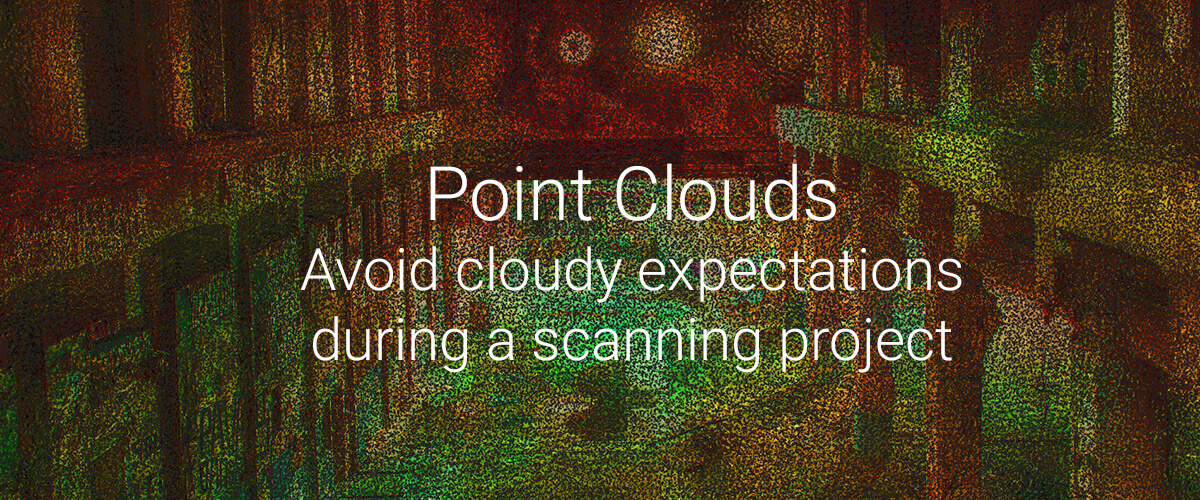Last week you read about the different types of scanners. This week's post gives you a starting point on what to keep in mind when you are planning a scanning project.
Planning a scanning project
For most people, buying a scanner will not be worth the investment. Luckily, there are several companies that offer scanning services. For those people, it might be useful to have an idea of the different steps in a typical scanning project.
There are three major phases:
- Preparing the project: everything before the actual scanning takes place.
- The scanning itself.
- Processing the scanning data and receiving the deliverables.

Figure 1: Scanner 1 can see object A, which hides everything behind it (in the light blue area). Scanner 2 can see objects A and B but nothing in the light red area. The purple areas are invisible for both scanners.
Preparation
Clients often underestimate this aspect but it is in fact the most important part. A key aspect here is making sure the client and the scanning company completely understand each other. When that is fixed, you can plan the details.
Avoiding misunderstandings
Write a detailed description of the final goals with specifications, required accuracies both in measurements (as in modeling) and all the related costs.
- Choosing between an exact representation of the building as-is, or an idealized representation in which walls are simplified.
- Which objects need to be measured, and with what level of accuracy?
- The responsibilities and rights of each of the parties involved must be decided ahead of scanning.
- What is the expected end product of the scanning project? Does the client order a point cloud to work on, or a full CAD model?
- What is practical versus what are the work requirements? Does measuring with higher accuracy justify the extra costs, time and effort?
- Check/estimate the expected size of datasets (number of Gb) and their corresponding processing times to make sure that the client has the proper hardware to work with the deliverables.
Practical planning
- Determine a set of scanner positions from where all the required areas can be scanned with the required accuracy. As discussed in the introduction, laser scanners can only see the outside surfaces of objects. Therefore objects hide what's behind them and additional scan positions are needed to include previously hidden areas. [Figure 1] illustrates this: while scanner 1 cannot see object B because it is behind object A (the blind spot of scanner 1 is illustrated by the light blue area), scanner 2 can see the bottom parts of objects A and B, but also has its own blind spots (shown by the light red areas). Planning must take that into account!
- Scanning time is expensive (man-hours, equipment), so make sure in advance that:
- planning includes sufficient scanner positions to scan all required areas
- operators can access all positions safely (such as when scanning in the presence of operating machines in a production hall)
- the location is suitable for scanning at the time of scanning (no disturbing vibrations, people or objects passing by, etc. )
- operators have permission to access all planned scanner positions
The scanning itself
Processing the data
- Registration: All the data from the different scans must be merged in the same coordinate system. Each scanner uses its own coordinate system. In order to obtain a single dataset from different scanner positions, all these data points need to be transferred into the same coordinate system ([Figure 2]). For this purpose, certain reference objects are used. This process is called "registration of the data".
- Quality verification. Operators use ground control points for this purpose. They measure these points in an alternative way and compare their positions with the position of corresponding points within the scans.
- Filtering the data: Removing noise; people who passed through in the scene during scanning, outliers due to reflections, etc.
- Modeling / measuring from the scanned data.

Figure 2: Registration of the point clouds from two different scanner locations (each with their own local coordinate system CS) to the same world coordinate system (WCS)
The results: point cloud files!
Things to consider
Let's assume that the client will do the actual modeling on their side and that they agreed with the scanning company that the deliverable is a set of clean, point clouds. Needless to say, when a scanner produces up to a million points per second, the resulting data sets haves sizes in the order of hundreds of Mb to hundreds of Gb. Being able to work with these huge datasets is not evident and has its own challenges, such as:
- Sufficient data storage on disc needs to be available, both for the raw and the derived data.
- Processing and interpretation of all the data can take hours and sometimes even days.
- Visualization and efficient navigation through these huge amounts of data can be very sluggish or even impossible without the proper hardware.
Types of file formats
To store point cloud data to disc, the data needs to be written to files. This can be a real pain since every company seems to work with their own format. This section will discuss some aspects of point cloud file formats and their properties. File formats can be:
- Open: a specification document and/or reference (implementation is openly available).
- Closed: files can only be read by software that has a license from the creator.
- Something in between: companies provide binary libraries for their file format, without exposing the file format specification itself.
File formats can be ASCII or binary. The first has the advantage that it is also human-readable and thus easily inspected to give an idea of what is inside, using a simple text reader such as Notepad. Of course, this type of file is by definition open, since even humans can read the content of the file. The disadvantage is that these files are slower to process since the text has to be parsed and interpreted. Binary files are the opposite: fast to read but difficult to inspect without the proper software if no specification of the format is available.
Examples of file formats:
- Closed, binary:
- Leica imp
- FARO fls
- Kubit ptc
- Autodesk rcp/rcs
- Open, binary:
- ASCII:
- ASCII variant of pcd
- Pts
- Ptx
- Xyz
Sometimes, file formats that are not strictly point clouds are also mentioned, like PLY, STL, OBJ, VTK, ... These files do not only contain point geometries and their properties, but also edges, faces, etc.
Next time
Return to the blog next week to learn about the different types of software available and some links to free dataset to experiment with.
Ready to try BricsCAD
Easy to try, easy to buy, easy to own. That's BricsCAD. Try all of our products, for free for 30 days at www.bricsys.com. Freedom of choice, plus perpetual (permanent) product licenses that work with all languages, in all places. You'll love what we've built for you with the BricsCAD product family.
Keep Reading
How to use point clouds in BricsCAD
- What's the point?
- Pointless without scanners
- Avoid cloudy expectations during a scanning project
- A cloud of software
- On point performance
- Scan-to-BIM

